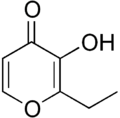Aroma compound
An aroma compound, also known as odorant, aroma, fragrance or flavor, is a chemical compound that has a smell or odor. A chemical compound has a smell or odor when it is sufficiently volatile to be transported to the olfactory system in the upper part of the nose.
Generally molecules meeting this specification have molecular weights of <300. Flavors affect both the sense of taste and smell whereas fragrances affect only smell. Flavors tend to be naturally occurring, and fragrances tend to be synthetic.[1]
Aroma compounds can be found in food, wine, spices, perfumes, fragrance oils, and essential oils. For example, many form biochemically during ripening of fruits and other crops. In wines, most form as byproducts of fermentation. Odorants can also be added to a dangerous odorless substance, like propane, natural gas, or hydrogen, as a warning. Also, many of the aroma compounds play a significant role in the production of flavorants, which are used in the food service industry to flavor, improve, and generally increase the appeal of their products.
Aroma compounds classified by structure
Esters
| Compound name | Fragrance | Natural occurrence | Chemical structure |
|---|---|---|---|
| Geranyl acetate | Fruity, Rose | Rose, Floral |
|
| Methyl formate | Ethereal | | |
| Methyl acetate | Sweet, nail polish Solvent |
| |
| Methyl propionate Methyl propanoate |
Sweet, fruity, rum-like | | |
| Methyl butyrate Methyl butanoate |
Fruity, Apple Pineapple |
Pineapple | |
| Ethyl acetate | Sweet, solvent | Wine | |
| Ethyl butyrate Ethyl butanoate |
Fruity, Orange Pineapple |
| |
| Isoamyl acetate | Fruity, Banana Pear |
Banana plant | |
| Pentyl butyrate Pentyl butanoate |
Fruity, Pear Apricot |
| |
| Pentyl pentanoate | Fruity, Apple | | |
| Octyl acetate | Fruity, Orange | | |
| Benzyl acetate | Fruity, Strawberry | Strawberries | |
| Methyl anthranilate | Fruity, Grape |  |
Linear terpenes
| Compound name | Fragrance | Natural occurrence | Chemical structure |
|---|---|---|---|
| Myrcene | Woody, complex | Verbena, Bay leaf | |
| Geraniol | Rose, flowery | Geranium, Lemon | |
| Nerol | Sweet rose, flowery | Neroli, Lemongrass |  |
| Citral, lemonal Geranial, neral |
Lemon | Lemon myrtle, Lemongrass | |
| Citronellal | Lemon | Lemongrass | |
| Citronellol | Lemon | Lemongrass, rose Pelargonium |
|
| Linalool | Floral, sweet Woody, Lavender |
Coriander, Sweet basil Lavender |
|
| Nerolidol | Woody, fresh bark | Neroli, ginger Jasmine |
|
Cyclic terpenes
| Compound name | Fragrance | Natural occurrence | Chemical structure |
|---|---|---|---|
| Limonene | Orange | Orange, lemon | |
| Camphor | Camphor | Camphor laurel | |
| Terpineol | Lilac | Lilac, Cajuput | |
| alpha-Ionone | Violet, woody | Violet |  |
| Thujone | Minty | Wormwood, lilac Juniper |
 |
Aromatic
| Compound name | Fragrance | Natural occurrence | Chemical structure |
|---|---|---|---|
| Benzaldehyde | Almond | Bitter almond | |
| Eugenol | Clove | Clove |  |
| Cinnamaldehyde | Cinnamon | Cassia Cinnamon |
 |
| Ethyl maltol | Cooked fruit Caramelized sugar |
 | |
| Vanillin | Vanilla | Vanilla |  |
| Anisole | Anise | Anise | |
| Anethole | Anise | Anise Sweet basil |
 |
| Estragole | Tarragon | Tarragon |  |
| Thymol | Thyme | Thyme | |
Amines
| Compound name | Fragrance | Natural occurrence | Chemical structure |
|---|---|---|---|
| Trimethylamine | Fishy Ammonia |
| |
| Putrescine Diaminobutane |
Rotting flesh | Rotting flesh | |
| Cadaverine | Rotting flesh | Rotting flesh | |
| Pyridine | Fishy | Belladonna | |
| Indole | Fecal Flowery |
Feces Jasmine |
 |
| Skatole | Fecal | Feces (diluted) Orange Blossoms |
 |
Other aroma compounds
Alcohols
- Furaneol (strawberry)
- 1-Hexanol (herbaceous, woody)
- cis-3-Hexen-1-ol (fresh cut grass)
- Menthol (peppermint)
Aldehydes
High concentrations of aldehydes tend to be very pungent and overwhelming, but low concentrations can evoke a wide range of aromas.
- Acetaldehyde (ethereal)
- Hexanal (green, grassy)
- cis-3-Hexenal (green tomatoes)
- Furfural (burnt oats)
- Hexyl cinnamaldehyde
- Isovaleraldehyde - nutty, fruity, cocoa-like
- Anisic aldehyde - floral, sweet, hawthorn. Cruical component of chocolate, vanilla, strawberry, raspberry, apricot, and others.
- Cuminaldehyde (4-propan-2-ylbenzaldehyde) - Spicy, cumin-like, green
Esters
- Fructone (fruity, apple-like)
- Hexyl acetate (apple, floral, fruity)
- Ethyl methylphenylglycidate (strawberry)
Ketones
- Cyclopentadecanone (musk ketone)[2]
- Dihydrojasmone (fruity woody floral)
- Oct-1-en-3-one (blood, metallic, mushroom-like)[3]
- 2-Acetyl-1-pyrroline (fresh bread, jasmine rice)
- 6-Acetyl-2,3,4,5-tetrahydropyridine (fresh bread, tortillas, popcorn)
Lactones
- gamma-Decalactone intense peach flavor
- gamma-Nonalactone coconut odor, popular in suntan lotions
- delta-Octalactone creamy note
- Jasmine lactone powerful fatty fruity peach and apricot
- Massoia lactone powerful creamy coconut
- Wine lactone sweet coconut odor
- Sotolon (maple syrup, curry, fenugreek)
Thiols
- Allyl thiol (2-propenethiol; allyl mercaptan; CH2=CHCH2SH) (garlic volatiles and garlic breath)[4]
- (Methylthio)methanethiol (CH3SCH2SH), the "mouse thiol", found in mouse urine and functions as a semiochemical for female mice[5]
- Ethanethiol, commonly called ethyl mercaptan (added to propane or other liquefied petroleum gases used as fuel gases)
- 2-Methyl-2-propanethiol, commonly called tert-butyl mercaptan is added as a blend of other components to natural gas used as fuel gas.
- Butane-1-thiol, commonly called normal butyl mercaptan is a chemical intermediate.
- Grapefruit mercaptan (grapefruit)
- Methanethiol, commonly called methyl mercaptan (after eating Asparagus)
- Furan-2-ylmethanethiol, also called furfuryl mercaptan (roasted coffee)
- Benzyl mercaptan (leek or garlic-like)
Miscellaneous compounds
- Methylphosphine and dimethylphosphine (garlic-metallic, two of the most potent odorants known)[3]
- Phosphine (Green Apple, Zinc Phosphide poisoned bait)
- Diacetyl (Butter flavor)
- Acetoin (Butter flavor)
- Nerolin (orange flowers)
- Tetrahydrothiophene (added to natural gas)
- 2,4,6-Trichloroanisole (cork taint)
- Substituted pyrazines
Aroma compound receptors
Animals that are capable of smell detect aroma compounds with olfactory receptors. Olfactory receptors are cell membrane receptors on the surface of sensory neurons in the olfactory system that detect air-borne aroma compounds.
In mammals, olfactory receptors are expressed on the surface of the olfactory epithelium in the nasal cavity.
Safety
'Fragrance' was voted Allergen of the Year in 2007 by the American Contact Dermatitis Society. The composition of fragrances are usually not disclosed in the label of products, hiding the actual chemicals of the formula, which raises concerns among some consumers.[6]
References
- ↑ Karl-Georg Fahlbusch, Franz-Josef Hammerschmidt, Johannes Panten, Wilhelm Pickenhagen, Dietmar Schatkowski, , Kurt Bauer, Dorothea Garbe and Horst Surburg "Flavors and Fragrances" Ullmann's Encyclopedia of Industrial Chemistry, 2003, Wiley-VCH. doi:10.1002/14356007.a11_141
- ↑ Gane S, Georganakis D, Maniati K, Vamvakias M, Ragoussis N, Skoulakis EMC, Turin L (2013). "Molecular vibration-sensing component in human olfaction." PLoS ONE 8, e55780. doi: 10.1371/journal.pone.0055780
- ↑ 3.0 3.1 Glindemann, D., Dietrich, A., Staerk, H., Kuschk, P. (2005). "The Two Odors of Iron when Touched or Pickled: (Skin) Carbonyl Compounds and Organophosphines". Angewandte Chemie International Edition 45 (42): 7006–7009. doi:10.1002/anie.200602100. PMID 17009284.
- ↑ Block, E. (2010). Garlic and Other Alliums: The Lore and the Science. Royal Society of Chemistry. ISBN 0-85404-190-7.
- ↑ Lin, D.Y., Zhang, S.Z., Block, E., and Katz, L.C. (2005). "Encoding social signals in the mouse main olfactory bulb." Nature 434, 470–477.
- ↑ Toxic chemicals linked to birth defects are being found at alarming levels in women of childbearing age
See also
- Flavour and Fragrance Journal
- Fragrances of the World
- Foodpairing
- Odor
- Odor detection threshold
- Olfaction
- Olfactory system
- Olfactory receptor
- Odorizer, a device for adding an odorant to gas flowing through a pipe
- Pheromone
- Aroma of wine
- Eau de toilette